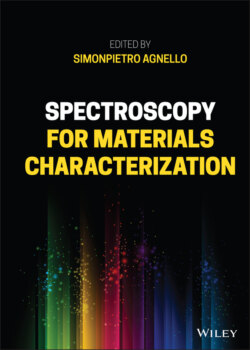Читать книгу Spectroscopy for Materials Characterization - Группа авторов - Страница 55
3.2.2.2 Noncollinear Optical Parametric Amplifier
ОглавлениеA noncollinear optical parametric amplifier (NOPA) is an optical device capable of producing tunable femtosecond radiation in the visible or near‐infrared region. The output of a NOPA is obtained by the interaction of two beams in a nonlinear crystal: a strong pump (ω p) and a weak and broadband seed (ω s < ω p). The pump is used to amplify the seed intensity, producing a strong output beam, named the signal, while creating another beam named idler at ω i, where ω p = ω s + ω i for energy conservation. In practice, the nonlinear process involved can be seen as difference frequency generation (DFG) between the pump and the seed. If the pump is the second harmonic at 400 nm of the Ti:sapphire beam, ω i falls in the infrared region, and the output signal wavelength can be typically tuned from 490 to 760 nm. Considering that the seed is a broadband pulse, changing the orientation of the nonlinear crystal allows to amplify different wavelengths based on the particular phase matching condition fulfilled in a given orientation [25].
Optical parametric amplification can be obtained either in a collinear or noncollinear geometry. The NOPA configuration uses the latter, allowing to compensate for the group velocity mismatch (GVM) between the two pulses (Figure 3.2a), which limits the interaction length and, therefore, the amplification of the seed into the signal.
Figure 3.2 Top: (a) Wavevectors of pump (), signal (), and idler () in the NOPA geometry; (b) group velocity mismatch of signal and idler pulses in collinear geometry and (c) in noncollinear geometry. The interaction length between the pulses is longer in (c) than in (b). (d) Phase matching curves for a NOPA pumped at 400 nm, as a function of the pump‐signal angle. (e) Solid curve: NOPA spectrum under optimum alignment conditions and a compressed seed; dashed line: sequence of spectra obtained by changing the white light chirp.
Source: Reprinted from [25], with the permission of AIP Publishing.
Bottom: Generation of supercontinuum pulse (white light) from a red pulse propagating in a centrosymmetric medium and supercontinuum spectrum generated by 800 nm beam pulse focused in a 2 mm D2O quartz cell filtered by a short‐pass filter at 750 nm.
The advantages of a noncollinear configuration can be also explained in different terms. In a noncollinear configuration, the crystal orientation angle at which phase matching occurs for amplification of a given wavelength becomes dependent on the angle α between the pump and signal wavevectors propagating inside the crystal, as in Figure 3.2d. In particular, as demonstrated in Figure 3.2e, the phase matching condition is simultaneously achieved over a very broad wavelength range when α ∼ 3.7∘. This allows to produce very broadband output pulses, which can be then compressed to very short temporal durations even below 10 fs. Usually, the output pulse is not broad as the near‐vertical line in Figure 3.2e because the seed is temporally chirped and the interaction with the pump only involves a relatively narrow portion of the seed spectrum. Then, changing the alignment (spatially and temporally) between pump and signal allows to amplify different portions of the spectrum, as shown by the dashed lines in Figure 3.2e.
